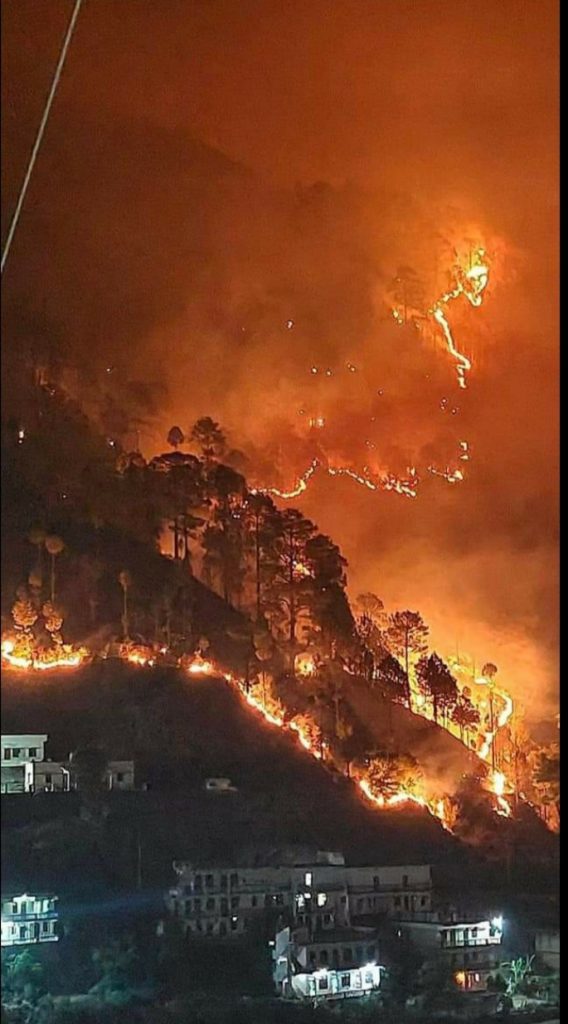GUEST COLUMN : The raging issue of forest fires & its solution

Uttarakhand has been at the center of greater debate for some time now for a different reason- natural disasters. For the past few years, life here has been threatened by a series of natural and man-made disasters. The intensity of these disasters is so high that the state has to face dire consequences at every level. Forest fires have prompted many of the state’s problems in recent years. According to an estimate, about 63 per cent of the fire incidents are man-made while the remaining 37 per cent are caused by natural causes. Both of them have one thing in common- they both result in a terrible calamity. Incidents of forest fires are a matter of concern all over the world. The recent events in California, Amazon and Australia are the latest examples of this.
Nowadays, once again there are reports of forest fires in almost the entire state. Lack of rain for a long time is one of the main reasons behind this. According to the Forest Survey Report 2021, 3,45,989 incidents of fire were registered across India from November 2020 to June 2021, which is a record in itself. Among the states, Odisha topped the list with 51,968 fire incidents while Uttarakhand was ranked sixth in the table. But in terms of active fire incidents, Uttarakhand ranked second after Madhya Pradesh where the number of active fires was 71 in 2021. The forests of Uttarakhand continued to burn for six consecutive months, breaking the previous year’s fire records. 71.5 per cent of Uttarakhand’s total land area is covered with forest, which shows that there is a lot of prosperity in terms of biodiversity. The state’s economy is also directly or indirectly dependent on forests so forest fires affect most activities of the state.
Earlier in 2016, all the past records were broken in cases of fire. There were 2,074 fire incidents at that time, destroying 4,433 hectares of forests, killing six persons and injuring four. Its magnitude can be gauged from the fact that on April 26 that year 1,200 forest fire incidents were recorded in a single day. This incident happened right in 2016 when political upheaval was going on in the state and efforts were on to save the then government, so apparently no special attention was paid to it.

According to the 2021 data, there were 989 incidents of fire from October 2020 to April 2021, in which 1,297.49 hectares of forest were destroyed. There were 470 such incidents in just three months from November 2020 to January 2021 as compared to 39 during the same period last year. There was a 177.96 percent increase in fire incidents in May 2021.
Due to the continuity of fire incidents in Uttarakhand, the fire season is generally considered from February 15 to the end of May, in which there is a spurt in forest fires due to dryness in the atmosphere and less rainfall. According to data, from January to March 2021, the state received only 10.9 per cent rainfall while it normally receives 549 per cent of the rainfall during this period. Therefore, forest fire can be considered as the main reason for this 80 percent drop in rainfall. These atmospheric changes result in decrease in rainfall. In the fire season in 2020, due to the cessation of human activities due to the Covid-19 pandemic, these incidents had decreased, but in 2021, reports of forest fires started again. This time too, all the meteorologists have expressed the possibility of less rainfall in the state, due to which there is a possibility of further increase in the intensity of forest fires. Uttarakhand is home to about 700 species of birds and fauna, more than half of all the species of the birds in India are found here along with the Ganga-Yamuna river system- the water tower for most of the states of north India. But the natural sources are drying up due to the continuous fire in the forests, due to which the water crisis is also arising in front of the state’s population.
Forest fires are also one of the reasons for the frequent landslides due to which the land becomes open and its water holding capacity is destroyed, as a result of which a large amount of soil gets washed away with rain water.
Mainly three factors are responsible for forest fires- heat (rise in global temperature, deforestation, formation of concrete forests), fuel (fuel, dry wood, leaves, resin) and oxygen. The Forest department has mentioned the main reasons for forest fires. The first reason is the careless leaving of burning beedis, cigarettes or other inflammable items in the forests. The second reason is controlled fire by the local people themselves for new grass etc, which sometimes spreads uncontrollably over a large area. The third is that forest is also set on fire by smugglers under a plan. It is commonly alleged that the Forest department also itself sets fire to hide the corruption prevailing in its works. Negligence by tourists, post-harvest fire in the fields, public negligence, clandestine pacts between timber mafia, saw mill owners, local touts, transport contractors and plantation contractors, government officials and some natural factors are also responsible for these incidents.
Why hasn’t a solution been found if the reasons are known? The simple answer is the lack of political will and administrative efficiency. We’ve seen in recent years that the administration was in panic at the decision-making level for the majority of the time because they lacked the expertise and skills to deal with such situations. There is a need to find a quick but far-reaching solution so that this kind of crisis does not start again. Highly vulnerable areas should be identified on the basis of past data before the disaster so that they can be mapped. As the most important step, the people must be made resourceful and empowered at the village level, because after the advent of the forest laws, the rights of the local people were reduced and their participation in forest conservation also ended. Therefore, the locals must be empowered to solve such problems because they have knowledge and experience of that particular area. Along with empowering the forest Panchayats, there is a need to connect forests with the economy so that people protect them from the point of view of employment. For example, if pine trees are replaced with fruit trees or herbs providing employment at local level, the people can play an active role in it. Pine trees are the biggest cause of fire and its forests are spread over a large area of the state, in which fire occurs two-three times in a single season because these forests are comparatively dry and the temperature varies greatly while the pine resin is flammable. In its place, broad-leafed Baramasi trees should be promoted, which not only keep the environment cool, conserve water but are also safe from the point of view of fire. Recently, Ravi Tamta, a young scientist from Almora, devised a machine which can extinguish fire without using water. Such a machine should be promoted by the government.
Such innovative programmes should be encouraged so that such technology can be invented at the local level itself. Awareness programmes should be promoted in schools, colleges, villages and cities to involve the public. This is a matter in which victory is possible only with the active participation of the government and the people. Robert Frost said in his famous poem Fire and Ice that the end of the world is possible only with fire and water. Seeing the situation in Uttarakhand at this time, it can be said that if efforts are not made in time, then this prediction can come true within a hundred years of his writing.
(The author is head of political science department at HNB Garhwal Central University. Views expressed are personal)






